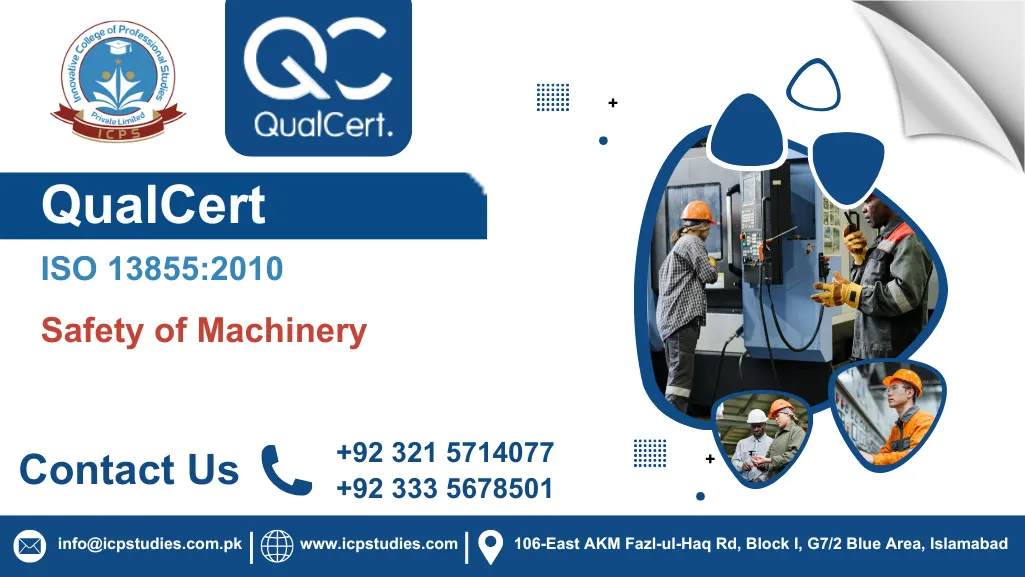The QualCert ISO 13855:2010 Safety of Machinery Course is a specialized program designed to provide learners with a comprehensive understanding of the internationally recognized standard for positioning protective equipment in relation to the approach speeds of parts of the human body. Rooted in ISO 13855:2010, this course emphasizes the importance of precision, consistency, and compliance in safeguarding machinery operations, ensuring that participants gain both theoretical knowledge and practical skills to evaluate and implement safety measures effectively. Learners will explore the technical requirements of the standard, the methodologies used in risk assessment, and the role of protective equipment in supporting workplace safety, regulatory compliance, and operational efficiency across diverse industrial sectors.
Throughout the course, participants will engage with the principles of machinery safety, including hazard identification, protective device positioning, calculation of safety distances, and integration of safety systems into machinery design. Practical exercises and case studies provide opportunities to apply ISO 13855:2010 requirements to real-world scenarios, enabling learners to develop confidence in conducting standardized safety assessments and implementing protective measures. The program also highlights the significance of machinery safety in areas such as manufacturing, engineering, and automation, equipping learners with the competence to contribute to safer workplaces and sustainable industrial practices.
Successful completion of QualCert ISO 13855:2010 Safety of Machinery demonstrates a high level of proficiency in applying ISO 13855:2010 standards to machinery safety and protective equipment positioning. Many learners use this qualification as a foundation for pursuing further certifications and diplomas in occupational safety, engineering safety systems, quality management, and advanced risk assessment methodologies. By undertaking this program, participants enhance their technical credibility, support organizational compliance, and position themselves as valuable contributors to industries where machinery safety and worker protection are critical to innovation, productivity, and global competitiveness.
All About QualCert ISO 13855:2010 Safety of Machinery
Course Overview
The QualCert ISO 13855:2010 Safety of Machinery Course is a specialized qualification designed to equip learners with the knowledge and skills required to apply internationally recognized standards for positioning protective equipment in relation to the approach speeds of parts of the human body. Rooted in ISO 13855:2010, the program emphasizes accuracy, consistency, and compliance in safeguarding machinery operations, ensuring participants gain both theoretical understanding and practical competence. Learners are introduced to the principles of hazard identification, protective device positioning, and calculation of safety distances, all of which are critical to achieving safe and efficient industrial practices.
This program is meticulously crafted to deliver focused and efficient skill development in the field of machinery safety. Learners engage in structured sessions, technical exercises, and industry-focused case studies, enabling them to apply ISO 13855:2010 standards effectively in real-world contexts. The course balances guided instruction with independent study, ensuring participants acquire meaningful expertise in standardized safety practices while developing confidence in risk assessment and protective equipment integration.
Participants will explore the technical requirements of ISO 13855:2010, including the positioning of safeguards such as light curtains, pressure-sensitive mats, and other protective devices. Practical exercises provide opportunities to conduct safety assessments, evaluate compliance with international benchmarks, and analyze the effectiveness of protective measures. The course also highlights the significance of machinery safety in supporting worker protection, regulatory compliance, and organizational efficiency, equipping learners with the competence to contribute to safer workplaces and sustainable industrial operations.
Completion of this program demonstrates a high level of proficiency in applying ISO 13855:2010 standards to machinery safety and protective equipment positioning. Many learners use this qualification as a foundation for pursuing further certifications and diplomas in occupational safety, engineering safety systems, quality management, and advanced risk assessment methodologies. By undertaking this course, participants enhance their technical credibility, support organizational compliance, and position themselves as valuable contributors to industries where machinery safety and worker protection are critical to innovation, productivity, and global competitiveness.
To enroll in the QualCert ISO 13855:2010 Safety of Machinery Course, applicants are expected to meet the following criteria:
- Age Requirement: Learners should be at least 18 years of age at the time of enrollment.
- Educational Background: A minimum of secondary-level education is required. Prior knowledge of engineering, occupational safety, or technical sciences is advantageous but not mandatory.
- Language Proficiency: As the course is delivered in English, participants must demonstrate sufficient proficiency in reading, writing, and communication to engage effectively with course materials and assessments.
- Work Experience: While not compulsory, prior professional experience in machinery operation, safety management, or engineering environments is highly recommended to support understanding and application of course content.
These entry requirements are designed to ensure that learners are well-prepared to benefit from the program and to apply their knowledge effectively in professional contexts. Meeting these criteria helps participants maximize their learning experience and successfully achieve the course outcomes.
The QualCert ISO 13855:2010 Safety of Machinery Course is designed for individuals who are motivated to strengthen their expertise in machinery safety and standardized protective equipment positioning. The ideal learner demonstrates a combination of academic readiness, professional experience, and personal attributes that enable them to succeed in a rigorous training environment and apply their learning effectively in real-world contexts.
Academic Readiness
- Possesses a solid educational foundation, ideally at secondary level or higher
- Demonstrates the ability to comprehend technical standards and structured course materials
- Shows proficiency in applying theoretical knowledge to practical safety scenarios
- Prepared to engage in independent study alongside guided learning hours
- Comfortable with analytical reading and professional writing tasks
Professional Background
- Has exposure to engineering, occupational safety, or machinery operation
- Understands organizational processes and the importance of compliance with safety standards
- Familiar with risk assessment methodologies or related industrial practices
- Brings practical insights from industry or service sectors
- Seeks to enhance career prospects through recognized technical competence
Language and Communication Skills
- Proficient in English for reading, writing, and verbal communication
- Able to participate actively in discussions, group exercises, and presentations
- Skilled in preparing clear reports and technical documentation
- Comfortable presenting findings to peers, management, and stakeholders
- Demonstrates confidence in professional communication settings
Analytical and Critical Thinking
- Capable of evaluating complex information and identifying key safety issues
- Applies logical reasoning to assess compliance with ISO 13855:2010 requirements
- Recognizes risks and opportunities within machinery safety systems
- Adopts a systematic approach to problem-solving and decision-making
- Demonstrates attention to detail in technical evaluations and audits
Personal Attributes
- Committed to professional integrity and ethical practices in engineering and safety management
- Motivated to contribute to innovation and sustainability in industrial safety
- Displays resilience and adaptability in challenging situations
- Works effectively both independently and as part of a team
- Maintains a learner-centered mindset with openness to feedback and improvement
Career Aspirations
- Seeks to establish credibility in machinery safety and standardized protective equipment positioning
- Intends to progress toward further certifications and diplomas in occupational safety, engineering safety systems, and quality management
- Aims to support organizations in achieving compliance and continual improvement
- Values professional development as a pathway to leadership roles
- Strives to make a positive impact on global innovation and workplace safety initiatives
The ideal learner for this course is someone who combines academic capability, professional insight, and personal commitment to excellence. By meeting these qualities, participants are well-positioned to succeed in the program and to apply their learning effectively in advancing machinery safety and standardized protective equipment practices.
Study Units
- Introduction to Machinery Safety and Risk Assessment
- Human Factors and Safe Distance Calculations
- Safety Devices and Control Systems
- Implementation of Protective Measures
- Compliance with ISO 13855 Standards
- Risk Management and Incident Investigation in Machinery Safety
Learning Outcomes
Introduction to Machinery Safety and Risk Assessment
- Demonstrate understanding of the principles of machinery safety and workplace hazard identification.
- Explain the importance of risk assessment in preventing accidents and ensuring compliance.
- Apply systematic approaches to evaluate risks associated with machinery operation.
- Recognize the role of ISO 13855:2010 in guiding protective equipment positioning.
- Develop competence in integrating safety considerations into machinery design and operation.
Human Factors and Safe Distance Calculations
- Explain how human factors influence machinery safety and protective equipment placement.
- Apply ISO 13855 methodologies to calculate safe distances for protective devices.
- Recognize the importance of approach speeds of body parts in determining safety measures.
- Evaluate scenarios where human behavior impacts risk levels and protective design.
- Demonstrate competence in applying safe distance calculations to real-world machinery contexts.
Safety Devices and Control Systems
- Identify different types of safety devices such as light curtains, pressure-sensitive mats, and interlocks.
- Explain the role of control systems in ensuring machinery safety and compliance.
- Apply knowledge of device positioning and integration to safeguard operators.
- Evaluate the effectiveness of safety devices in reducing risks and preventing incidents.
- Demonstrate competence in selecting and configuring appropriate safety systems.
Implementation of Protective Measures
- Apply ISO 13855 requirements to implement protective measures in machinery environments.
- Demonstrate competence in integrating safety devices into operational processes.
- Evaluate protective measures for effectiveness, reliability, and compliance.
- Recognize the importance of continuous monitoring and maintenance of safety systems.
- Recommend improvements to enhance workplace safety and operational efficiency.
Compliance with ISO 13855 Standards
- Demonstrate understanding of ISO 13855:2010 requirements for protective equipment positioning.
- Apply compliance frameworks to ensure adherence to international safety standards.
- Evaluate organizational processes for alignment with ISO 13855 guidelines.
- Recognize the role of compliance in reducing liability and enhancing workplace safety culture.
- Demonstrate competence in documenting and reporting compliance outcomes.
Risk Management and Incident Investigation in Machinery Safety
- Apply risk management principles to identify, assess, and mitigate hazards in machinery operations.
- Demonstrate competence in conducting incident investigations to determine root causes.
- Evaluate corrective actions to prevent recurrence of safety incidents.
- Recognize the importance of continuous improvement in machinery safety management.
- Present findings and recommendations in alignment with ISO 13855 standards and organizational policies.
These outcomes ensure learners develop both technical knowledge and applied competence, preparing them to use ISO 13855:2010 standards effectively in machinery safety, protective equipment positioning, and workplace risk management.
FAQs About QualCert ISO 13855:2010 Safety of Machinery

